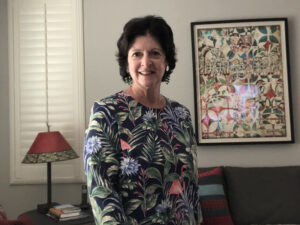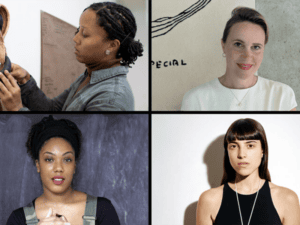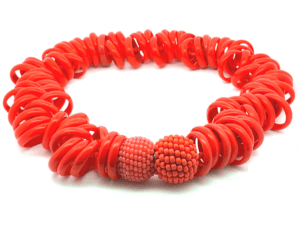
Susan Cummins: Réka Fekete, you are Hungarian by birth, and I understand that you moved to Amsterdam in 2004 when you were 22 years old. Do you think you brought something particularly Hungarian to your studies at the Gerrit Rietveld Academy?
Réka Fekete: I think it is rather my family and the environment my parents created in Hungary that most influenced my way of experiencing everything as being either fascinating, beautiful, ugly, or something else. My grandfather was a painter while my grandmother worked as a goldsmith and as a ceramicist. They had a huge studio in the basement of the house where I grew up where they worked with several other artists. The house was built in the 1930s in the Bauhaus style, and their work hung on our walls. These aspects were not particularly Hungarian, but they are what remain most present for me. I am certain that the impact of this environment left me with impressions and aesthetics I carry with me wherever I go.

Réka Fekete: Iris Eichenberg was my mentor for the first year of my jewelry studies at the Gerrit Rietveld Academy in 2006. Her teaching approach and her confidence in me had a huge effect on the discoveries I made. She gave me the feeling of possibilities and the freedom to explore. This freedom led me to use zinc for the first time, and my fascination for architecture began to appear in my work. I started to present the deterioration of buildings as a form of beauty. For me, it was very important to see how Iris touches all the subjects and materials she works with, how close she is to them, and how much her heart is in her work.
I had already interned for Beppe Kessler during my studies. Apart from jewelry, I also make objects, usually objects that hang on the wall. Beppe also works in two different disciplines, so for me it was very inspiring to see how she divides her attention and time between painting and jewelry. Beppe often uses materials as a starting point by building up her materials and then reducing them by carving. It is a very specific and fascinating way of working for me because it is different from how I approach material. She also taught me to experience mistakes and accidents as new opportunities and to be more easygoing when something turns out differently than expected.
I think it was extremely useful and also joyful to see how established artists schedule their days outside of all the time devoted to making. The administrative tasks, such as keeping track of the jewelry going to exhibitions, deciding which ones form coherent groups, and also how to display them, are all part of being an artist. While assisting Iris and Beppe, I saw different ways of doing things and how to deal with this life. The opportunity to experience different artists’ way of life gives a student a glimpse of how they could develop the different paths available to them.

Réka Fekete: Yes, I helped to organize Onno Boekhoudtʼs legacy, which was basically everything from his practice. It was all left to the museum. I catalogued many of his pieces and looked through a lot of his notes and books. It felt as if I was one of his last students. I later realized that the most important thing about this permanent collection is that it will be available for many more people, so in a way, they will all be his last students, too.
For me, Onno Boekhoudt’s work had a peaceful atmosphere about it, probably because of his free approach and his ability to convey a feeling of spaciousness. There were endless experiments, which only exemplified the beauty that lies in trying things out. They could be the work itself. How pretty imperfections become when the piece is obviously made with care. Often, the focus was not on the perfection but on the underlying feeling and idea. His joy for the work, his curiosity for details, and their influence on the whole was impressive.
For two months I worked at the museum, and I am grateful to have seen his work and had my hands on it. Each morning and each evening, I spent the 1-hour commute drawing. I did not have time to make three-dimensional work while I was interning, but once I had the time to make work again, the outpour was enormous. All the input and sensations from Onno’s work had piled up inside me, and drawing was no longer enough. I was already drawn to geometrical shapes, but my attraction grew stronger, especially for imperfect rectangular shapes. I think that I returned to etched zinc because of my exposure to Onno Boekhoudtʼs use of lead. The color similarities of the two metals led me to find the main material for my graduation work.
Why is your show called Balance?
Réka Fekete: As well as in my previous series, I am experimenting with movement within these pieces. Movement stands for personality, for the ever-changing quality of life, and for the freedom in it. The way I connect the elements gets special attention this time. The connection itself becomes so prominent that it appears to be the main element. Other times, the elements fit into each other and are hammered together so an extra connecting element is no longer needed. Within the construction of each piece there is a lot of mobility and different ways of wearing it. This mobility also expresses how I am in my life. At any moment I might change my mind and take a new path in order to maintain my balance, which I think is one of the most fundamental aspects of life. No matter how much you reduce and consolidate as long as the components of each side remain in balance you will be fine. I see the act of preserving this balance as an exchange. It is simply the way we live and just like the different kinds of relationships that exist between people.

How does this new work differ from the work you were doing last year?

For my installation at Galerie Ra, I added some drawings on the wall as well. I wanted the wall to be more than an object upon which the pieces are presented. Acting like a huge piece of paper, the wall becomes part of the work, connecting the pieces and bridging the surfaces and the jewelry. In this series of work, I began to paint on the wood with my fingers instead of spraying each piece with one color. This process allowed me to discover a very liberating way of interacting with my materials. I think I was able to bring similar effects to the wall of the gallery. Overall, this new body of work has evolved graphically, especially within the shadows where the linearity of the steel is constantly reflected.
Thank you.
Réka Fekete: My pleasure. Thank you!





